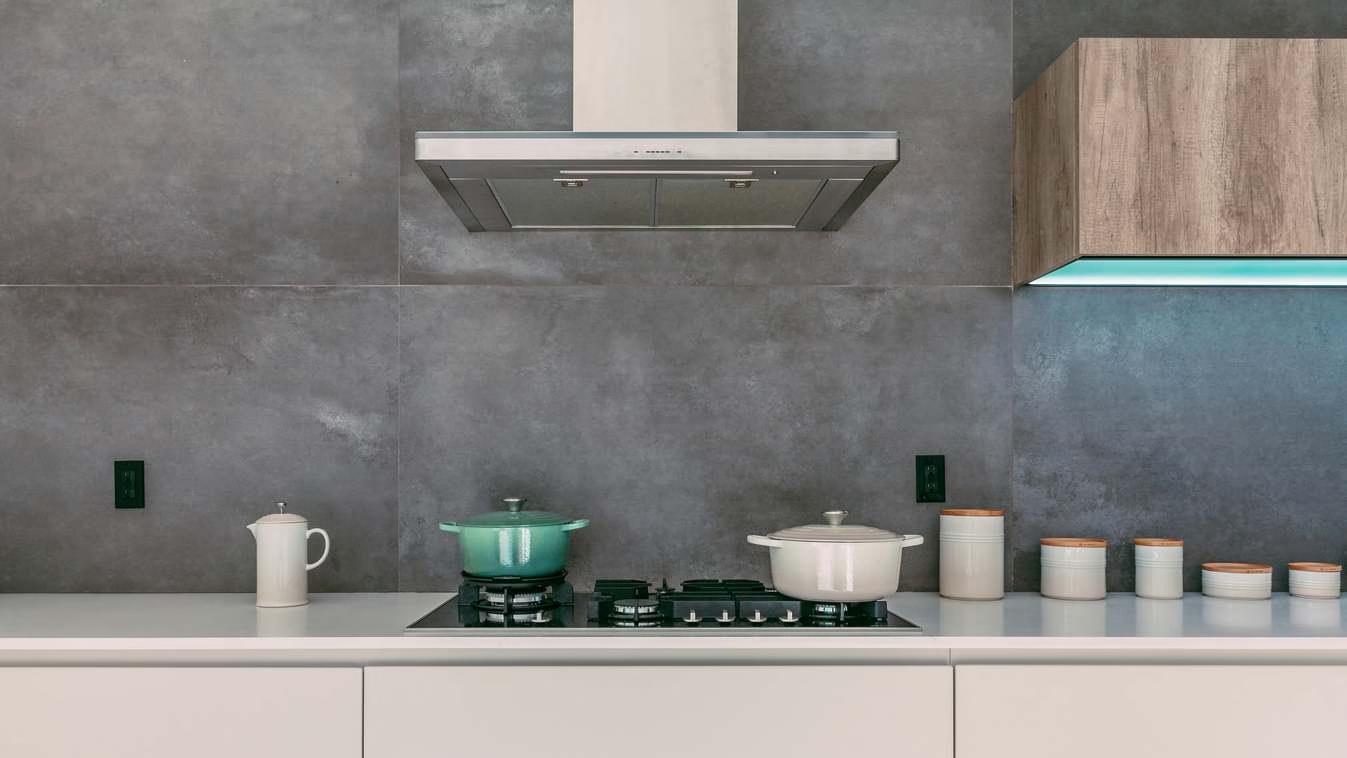Learn how to install a ducted or ductless under cabinet range hood safely and correctly—even if you’re a beginner. Includes wiring, venting & mounting tips.
Table of Contents
Introduction
Putting in an under cabinet range hood can change your kitchen. It can go from smoky and greasy to clean and nice to cook in. You might be putting in a new one or replacing an old one. This guide will show you how to do it step by step. In 2025, new models use less energy and are smarter. Setting it up right means it works well, is safe, and lasts long. You may also like to read best Top 5 on the market review.
Why do it yourself? Hiring someone can cost $200 to $500 or more. But with the right tools and help, you can save money. You will also feel good about doing it yourself. This guide talks about two types: ducted and ductless. They are set up a bit differently. Ducted hoods push air outside. This makes the air better. Ductless hoods clean the air and push it back in. This is good for apartments or homes that can’t vent outside.
We will start with getting ready. Then we will go through each step. We will cover wiring and venting. We will also point out common mistakes. When you finish, you will have a hood that works well. It will follow building rules and help your kitchen air move better. If you have not picked a model yet, this guide thinks you have. But for ideas, see our reviews of the best under cabinet range hoods.
This job may take 4 to 8 hours if you are new to it. It depends on your setup. Let’s begin!
Tools and Materials You’ll Need
Before you start, get all your stuff together. This way, you won’t have to stop and go to the store. Here is a full list for under cabinet installs:
Essential Tools
– Tape measure and level: To measure right and make sure the hood is straight.
– Drill and bits: To make holes for vents and mounting.
– Jigsaw or saw: To cut cabinet parts if needed.
– Screwdrivers: To turn screws.
– Wire strippers: To work with wires.
– Stud finder: To find wall studs.
– Pencil and tape: To mark spots.
– Caulk gun: To seal vents.
– Safety gear: Gloves, goggles, and a mask to stay safe.
– Ladder: If your cabinets are high.
– Utility knife: To cut tape or insulation.
Materials
– Range hood kit: Has the hood, brackets, screws, and maybe a guide.
– Ductwork: For ducted types. Use metal duct, tape, and clamps.
– Vent cap: For outside venting to keep air and pests out.
– Electrical items: Wire nuts, tape, and maybe a box for wires.
– Charcoal filters: For ductless types if not included.
– Sealant: To fill gaps and stop air leaks.
– Wall anchors: If no studs in the wall.
– Wood or shims: To make cabinets strong if they are weak.
Tip: Check your hood’s guide for what you need. Models are not all the same. You might spend $50 to $150 on tools if you don’t have them. But many you may already own.
Safety Precautions Before You Start
Safety comes first. If you set it up wrong, it could cause electrical fires, bad air flow, or carbon monoxide. Do these things:
– Turn off power: Go to your circuit breaker and cut power to the kitchen. Use a tester to check that wires are dead.
– Ventilate the area: Work where air can flow well. This is key if you cut into walls.
– Wear safety items: Goggles keep eyes safe. Gloves stop cuts. A mask keeps dust out.
– Check local rules: Building codes might need certain vent sizes or heights. Some places need a permit for outside vents.
– Get help for heavy things: Range hoods weigh 20 to 50 pounds. Ask a friend to hold it when you put it up.
– Gas stove note: If you have a gas cooktop, make sure the hood is made for it. Put it at least 30 inches above to avoid fires.
– Don’t do it if unsure: If your home has tricky wires or you don’t like electrical work, hire an expert. It costs $100 to $300.
Remember, ducted installs need you to cut holes. Check for pipes, wires, or insulation behind walls. Use a stud finder that finds wires too.
Preparation: Planning Your Installation
Good prep helps you succeed. Spend 30 to 60 minutes on this to avoid doing things over.
Measure Twice, Cut Once
– Hood place: Put the hood 24 to 30 inches above an electric stove. For gas, put it 30 to 36 inches up. This is for safety and good work. Center it over the stove. Most are 30 to 36 inches wide to fit common ranges.
– Cabinet check: Make sure the cabinet above is at least 18 inches deep and strong. If not, add wood to make it strong.
– Venting path: For ducted, plan the shortest and straightest way outside. Avoid sharp turns. They can cut air flow by half.
– Electrical access: Find a nearby outlet or wire box. Hoods need 120V power from a 15 to 20 amp circuit.
Ducted vs. Ductless: Which to Choose?
– Ducted: Best for lots of cooking. It takes smells and grease outside. You need to vent outside. It moves more air.
– Ductless: Easier to put in. No holes outside. It uses filters to clean air. But it puts humidity back in. Change filters every 3 to 6 months. Good for light use or rentals.
Use the maker’s guide to mark holes on the cabinet bottom.
Removing an Old Hood (If You Have One)
– Turn off power and unplug.
– Take off mounting brackets and disconnect ducts and wires.
– Have a helper hold the hood while you remove it.
– Clean the area well to get rid of grease.
Step-by-Step Installation for a Ducted Under Cabinet Range Hood
This type takes more work. But it moves air the best. Follow these steps with care.
Step 1: Mark and Cut Vent and Electrical Holes
– Put the guide on the cabinet bottom. Mark the vent hole and electrical spot.
– Drill small holes first. Then use a hole saw for the vent. For walls, cut from inside and outside for best results.
– If venting through the roof, make sure the path is clear. Use a roof cap.
Tip: Seal inside cuts with foil tape to stop air leaks.
Step 2: Install Mounting Brackets
– Find studs or use anchors.
– Screw brackets into the cabinet bottom or wall. Make sure they are level. Most hoods have slots for easy hanging.
– For extra support, add back brackets if needed.
Step 3: Prepare the Ductwork
– Attach the damper to the hood’s exhaust. It stops cold air or pests from coming in.
– Connect flexible duct to the damper with clamps. Run it to the outside.
– Put on the outside vent cap. Cut a hole in the wall. Put in the cap. Seal it with caulk. Screw it in place.
Tip: Use rigid duct for long runs. This cuts noise and helps air flow. Total duct length should not be more than 50 to 100 feet.
Step 4: Wiring the Range Hood
– Feed wires through the electrical hole.
– Strip half an inch from wire ends.
– Connect black wire to black, white to white, and green or copper to the ground screw.
– Use wire nuts. Twist them tight. Wrap with electrical tape.
– Put wires in the box and close it.
If no wires are there, run new cable from the breaker. Ask an electrician for this.
Step 5: Mount the Hood
– With help, lift the hood and hang it on the brackets.
– Secure it with more screws from inside the cabinet.
– Make it level. Tighten all parts.
Step 6: Connect the Duct and Finalize
– Attach the duct to the outside vent.
– Seal all joints with foil duct tape. Don’t use regular tape.
– Put back filters or grease traps.
Step 7: Test Everything
– Turn power back on.
– Turn on the fan at all speeds. Listen for odd sounds.
– Check lights. See if air moves well. Hold a tissue to the filters. It should pull in.
– Smoke test: Burn a piece of toast. See if smoke clears fast.
If problems, check connections again.
Step-by-Step Installation for a Ductless Under Cabinet Range Hood
Ductless installs are faster. They take 2 to 4 hours.
Variations from Ducted
– Step 1: No vent cutting. Skip outside holes. The hood moves air through top vents.
– Steps 2 to 4: Same as ducted. Mount brackets and wire if needed.
– Put in filters: Add charcoal filters as per the guide. They catch smells. Grease filters go on the bottom.
– Mount and test: Do steps 5 to 7. Check that air comes out from top vents.
Tip: Ductless hoods can be noisy at high speeds. Pick quiet models.
In-Depth Wiring Guide
Wiring is key for safety. Most hoods plug in. But hardwired ones need:
– Voltage check: Make sure it’s 120V AC.
– Circuit power: Use a separate 15-amp circuit to avoid overload.
– Grounding: Always connect the ground wire to prevent shocks.
– Extra wiring: If needed, use 14-gauge cable. Run it safely in walls. Avoid sharp bends.
Common issue: Lights flicker if connections are loose. Tighten and test again.
If your hood has smart features, set them up after power is on.
Comprehensive Venting Guide for Ducted Hoods
Venting helps remove smoke well. Key points:
– Duct size: Match the hood’s port. Usually 6 to 8 inches. Small ducts cut air flow.
– Path: Use the shortest route. Each sharp turn acts like adding 5 to 10 feet of duct.
– Materials: Use metal only. Plastic can melt. In cold areas, insulate to stop condensation.
– Backdraft damper: Needed to stop outside air from coming in.
– Roof or wall venting: Wall is easier. Roof needs flashing to stop leaks.
Find needed air flow: Kitchen size in square feet times 15, then divide by 60. For a 200 sq ft kitchen, you need at least 50 units of air flow. But aim higher if you cook a lot.
Common Mistakes and How to Avoid Them
Even experts make errors. Watch for these:
1. Wrong height: Too low can cause fires. Too high won’t catch smoke well. Measure from the stove top.
2. Bad sealing: Leaky ducts waste energy. Use good tape and caulk.
3. Ignoring codes: No damper? Air can come back in. Check rules.
4. Forgetting filters: Put in grease filters right away to catch spills.
5. Wiring errors: Wrong wires can cause shorts. Check colors twice.
6. Uneven mounting: Use a level. Crooked hoods look bad and may shake.
7. Long duct runs: Too long cuts suction. Change the path if needed.
8. Skipping tests: Always check after install to find issues early.
Fixes: No power? Check the breaker. Weak suction? Clean filters or straighten ducts. Noisy? Tighten loose parts.
Post-Installation Maintenance Tips
Your hood will last over 10 years with care:
– Clean filters each month: Metal ones can go in the dishwasher. Change charcoal every 6 months.
– Wipe surfaces: Use mild soap to remove grease. Don’t use rough pads.
– Check ducts each year: Look for blocks or damage.
– Professional checks: Every 2 to 3 years for wires and fan.
– Save energy: Use low speed for light jobs to use less power.
Conclusion
Great job! You now know how to install an under cabinet range hood. From getting tools to testing, these steps give you a safe and good air system. It keeps your kitchen fresh and fun to cook in. Whether you picked ducted for best work or ductless for easy setup, your work will lead to better air and happy cooking.
If you run into tough parts like hard venting, call a pro. If you are still looking for a hood, see our best under cabinet range hoods to find one you like. Enjoy your new kitchen!



